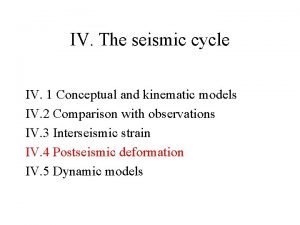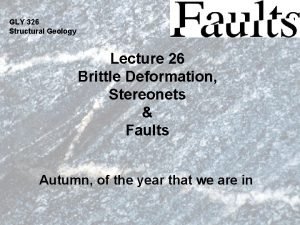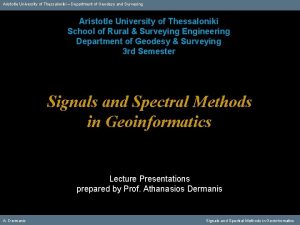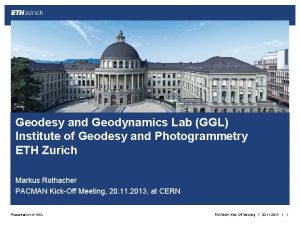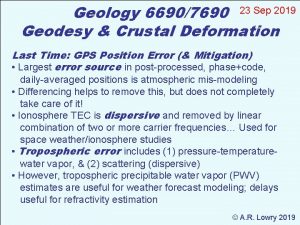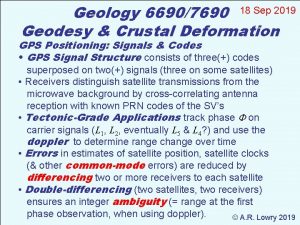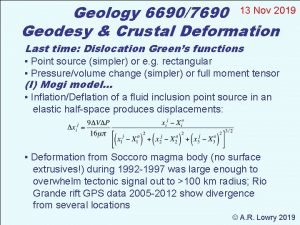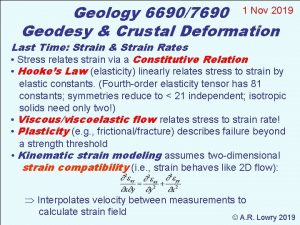Geology 66907690 30 Sep 2019 Geodesy Crustal Deformation







- Slides: 7

Geology 6690/7690 30 Sep 2019 Geodesy & Crustal Deformation Last Time: Herring et al. (2016) Rev. Geophys. on analysis of PBO products… • The North America reference frame is defined by minimizing velocities in “stable” North America; find large (sometimes surprising) velocities in deforming zones… • Global reference frame is time dependent and changes with global CGPS site sampling, new satellites, … • CWU positions differ from NMT because point-positioning is sensitive to satellite clock/orbit errors while differencing is not. PBO over-weighted CWU because frame errors were neglected in variance estimates! • To accurately capture mass loading deformation, scale should be neglected or removed globally rather than regionally… © A. R. Lowry 2019

Secular Velocities. . . Different applications entail different model assumptions: One common starting point for velocity is “plate motion”, which assumes motion of a rigid plate on the surface of a spherical Earth ( no strain!) Bird, Geochem. Geophys. Geosys. , 2003

Secular Velocities. . . • “Geologic” Plate Velocity Models use “geologic data”, including ocean ridge opening rates derived from dated seafloor magnetic anomalies; relative plate motion directions inferred from transform faults; earthquake slip vectors… Courtesy USGS • Effectively average over the past 3 million years (because of the need for magnetic anomaly rate constraints)… • No-Net Rotation (NNR) versions of plate models (comparable to GPS frame) include NNR-NUVEL-1 A by De. Mets et al. (1990; 1994); NNR-MORVEL 56 by Argus et al. (2011)

Plate Velocity Modeling using Euler Poles: Assumes rigid “blocks” (or “plates”) move independently relative to one another across the Earth’s surface. • Each block will have an Euler Pole: For the p’th block, means the block rotates at angular velocity p around the pole at latitude p, longitude p. Then the velocity at any point on the block is given by: Assumes? How small a “plate” can we reasonably expect? Altamimi et al. (2012) adds an “origin rate bias” term: which is purely a reference frame issue related to inadequacy of sampling & our poor knowledge of surface mass change.

The IGS 20 xx Reference Frames first and foremost define global plate & deforming-zone GPS velocities. Note: • X, Y, Z refers to the Earth-centered, Earth-fixed GPS coordinate system. We use coordinate transformations to convert these to more familiar lat, lon, height above an ellipsoid… • “Origin rate bias” is translation rate of the X, Y, Z = 0 origin of the coordinate frame • They also find a global rotation-rates (primarily in the X-axis) that describe differences between IGS and other NNR frames These are rooted in issues of inadequate sampling of the global velocity field & neglect of global surface mass change.

Altamimi et al. , JGR 2012 The good news is (here, IGS 2008) estimates of translation rate are not significant at 95% confidence (and can be thought of more as just an expression of uncertainty in motions introduced by the sampling geometry!)

Modeling GPS Velocities: Velocities (i. e. , the secular changes or “trends” in position, dxi/dt) are important observables for several different applications: • Critical first-order term needed to define the GPS reference frame (positions are referenced to these!) • Critical first-order term for assessing interseismic strain rates (strain is the spatial derivative of displacement!) • Necessary baseline for evaluating temporal changes in behavior!


